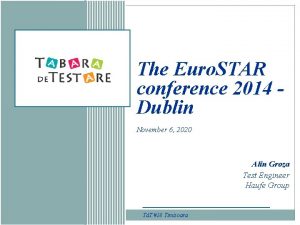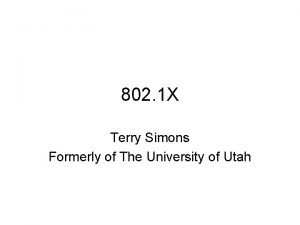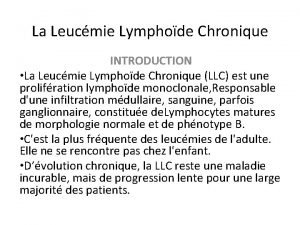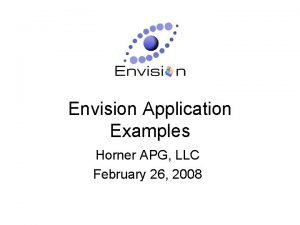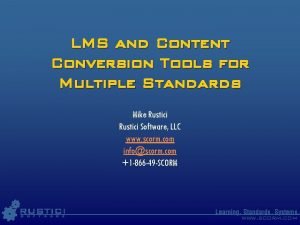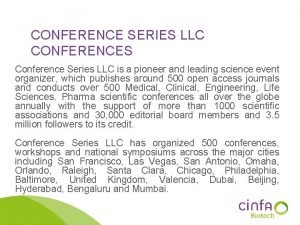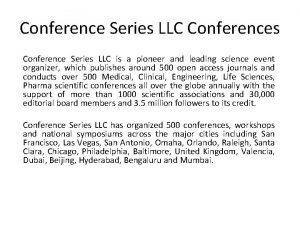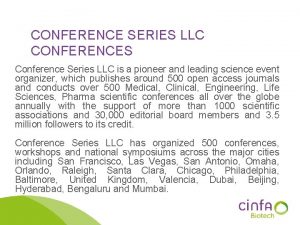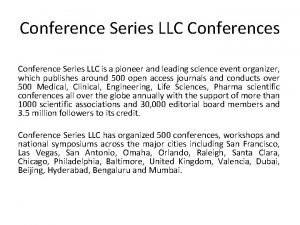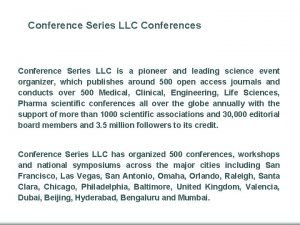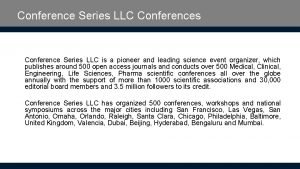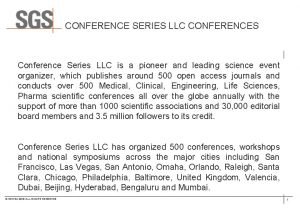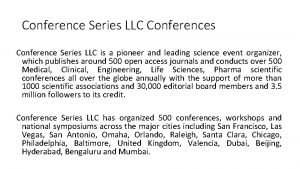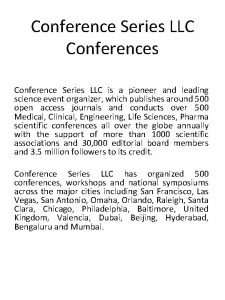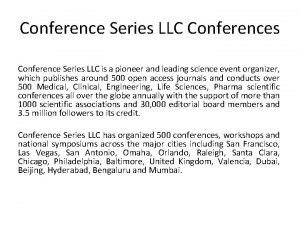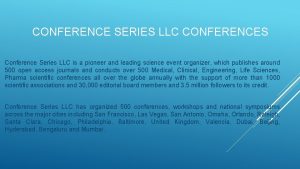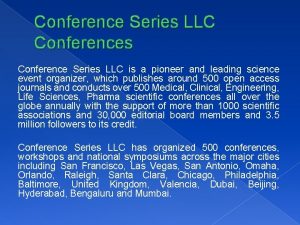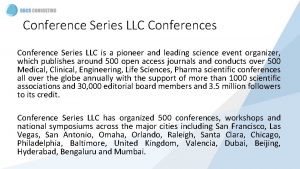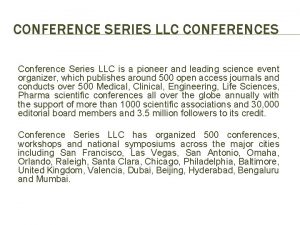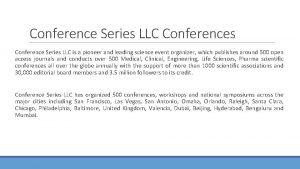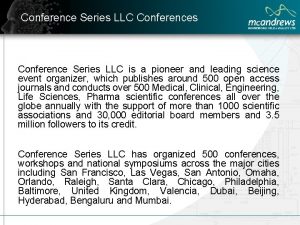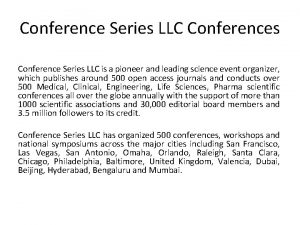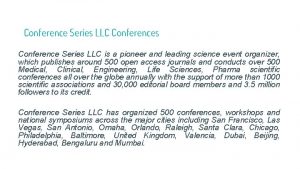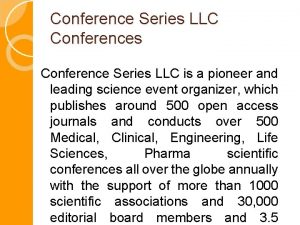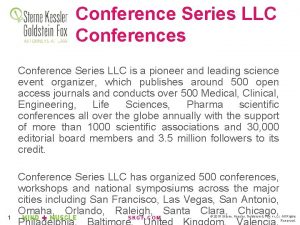Conference Series LLC Conferences Conference Series LLC is


![What are the siloxanes? …. are composed of repeating this backbone –[R 2 Si–O]– What are the siloxanes? …. are composed of repeating this backbone –[R 2 Si–O]–](https://slidetodoc.com/presentation_image_h/e22cacdaa325d45ad48bf75cd47e0386/image-3.jpg)



























- Slides: 30

Conference Series LLC Conferences Conference Series LLC is a pioneer and leading science event organizer, which publishes around 500 open access journals and conducts over 500 Medical, Clinical, Engineering, Life Sciences, Pharma scientific conferences all over the globe annually with the support of more than 1000 scientific associations and 30, 000 editorial board members and 3. 5 million followers to its credit. Conference Series LLC has organized 500 conferences, workshops and national symposiums across the major cities including San Francisco, Las Vegas, San Antonio, Omaha, Orlando, Raleigh, Santa Clara, Chicago, Philadelphia, Baltimore, United Kingdom, Valencia, Dubai, Beijing, Hyderabad, Bengaluru and Mumbai.

5 th Global Pharmacists Annual Meeting July 14 -16, 2016 Brisbane, Australia 1 Medical University of Gdańsk Faculty of Pharmacy with Subfaculty of Laboratory Medicine Poland What are the consequences of impact of the siloxanes (silicones) on the skin barrier? Krystyna Mojsiewicz- Pieńkowska 1 Katarzyna Szymkowska 1, Dominika Glamowska 1 , Krzysztof Cal 2, Zbigniew Jankowski 3, Rafał Bartoszewski 4, Sylwia Bartoszewska 4, Michał Pikuła 5 1 Department of Physical Chemistry of Pharmaceutical Technology 3 Department of Forensic Medicine 4 Department of Biology and Pharmaceutical Botany 5 Department of Clinical Immunology and Transplantology 2 Department
![What are the siloxanes are composed of repeating this backbone R 2 SiO What are the siloxanes? …. are composed of repeating this backbone –[R 2 Si–O]–](https://slidetodoc.com/presentation_image_h/e22cacdaa325d45ad48bf75cd47e0386/image-3.jpg)
What are the siloxanes? …. are composed of repeating this backbone –[R 2 Si–O]– R 2 - various chemical groups: - methyl group - ethyl group - propyl group - fluoroalkyl group - aminoalkyl group - phenyl group - vinyl group - CH 3 - CH 2 CH 3 -CH 2 CH 3 -FCH 2 CH 3 -NH 2 CH 2 CH 3 -C 6 H 5 - CH=CH 2 2

Principal structures of siloxanes 3 Depending on the size of the molecule and the shape of the skeleton siloxanes can be: No. Name of structure 1. Linear 2. Cyclic Characteristic these are volatile and non-volatile fluids: for example: Dimethicone these are volatile fluids: for example Cyclomethicone present in: resins, adhesives, 3. Branched for example silicone rubbers Soft Skin Adhesives from Dow-Corning company 4. 5. Cross-linked I networks present in: resins, rubbers, elastomers; elastomers are used in the treatment of keloids and scars for example Cica-Care Cross-linked present in: resins which can easily transform into II networks a three-dimensional network Shape of structure

Methylsiloxanes – the important groups of silicones Linear: Methyl Siloxanes Cyclic: Cyclomethicone Octamethylcyclotetrasiloxane, n=4 D 4 Decamethylcyclopentasiloxane, n=5 D 5 n - degree of polymerization Dodecamethylcyclohexasiloxane, n=6 D 6 4

5 Octamethylcyclotetrasiloxane, n=4 D 4 Decamethylcyclopentasiloxane, n=5 D 5 Dodecamethylcyclohexasiloxane, n=6 D 6 Type of linear methylsiloxanes Low molecular weight Degree of polymerization Molecular number n [Da] 0 162 2 Medium molecular weight Degree of polymerization Molecular number n [Da] 0. 65 50 3 500 237 1 125 8 770 5 15 1 250 25 2 000 weight High molecular weight Degree of polymerization Molecular number n [Da] 50 1230 91 000 30 000 9 500 200 1 500 116 500 60 000 190 13 600 350 1 870 139 000 100 000 10 400 30 000 1 000 2 750 204 000 300 000 20 800 60 000 10 000 4 160 308 000 1 000000 Viscosity [c. St] weight Viscosity [c. St] According to the Pharmacopoeia, only medium molecular weight of linear methylsiloxane may be used orally. Simethicone USP 410 c. St = 15 000 Da are used as antifoaming drugs ! Dimethicone The researchers argue that medium molecular weight is safe for human being.

Why should we be interested in silicones? 6 Due to the unique physico-chemical properties siloxanes are used in a wide variety of applications, for example in: Medicinal products as an active pharmaceutical substance in Dimethicone or Simethicone where are used as antifoaming drugs Food as a functional additive (E-900) A human being has a direct contact with silicones through: Cosmetics for example: creams, lotions, shampoos Medical devices for example: implants, prosthesis, endotamponade, silanized surfaces of syringes

Why should we be interested in silicones yet? 7 A human being may have a direct contact of the silicones with skin by: PHARMACEUTICAL INDUSTRY COSMETIC INDUSTRY DERMAL MEDICINAL PRODUCTS PERSONAL CARE PRODUCTS AND COSMETICS using • ointments against infection pathogens • gels for keloids • ointments for scars • emollients for atopic dermatitis • products against lice ENVIRONMENT because of the significant amounts of silicones as the contaminants found in: • Soil • Water • Air using • hand face cream • lotions and masks • protective creams against UV radiation • face gels Contamination problem • antyperspirants, deodorants is described in the reports • shampoos of governments: Canada, Sweden and Denmark.

Why should we be interested in silicones yet? 8 Generally, siloxanes are considered as non-toxic. In literature there is reported an impact on: Current knowledge confirms that the structure and size of molecule affects the absorption, migration and toxicity for human being. REPORTS 1948 – 2015 ABOUT the TOXICITY both the linear and cyclic structure especially with low molecular weight ENVIRONMENT CONTAMINATION Changing of protein’s conformation Soil Immune system Water Endocrine system Air Increase in liver enzymes Impact on the human skin (irritations and inflammations, cyst formations) Genotoxicity Nerve system and impact on the peripheral neuropathy Migration in the body and accumulation in tissues (brain, the spinal cord, liver) as well as adverse reactions in intraocular tissues

9 Regarding the safety assessment of using low molecular weight siloxanes, it seems to be necessary to verify the possibility to overcome skin barier by these substances. Therefore we asked: IF SILICONES HAVE THE ABILITY TO OVERCOME HUMAN SKIN BARRIER?

10 In the studies three issues were considered: 1) human skin structure and its impact on the overcoming skin barrier by siloxanes 2) possible pathways to enter the skin 3) physico-chemical properties of these xenobiotics

Human skin barrier includes: stratum corneum, epidermis and dermis 11 SC is composed of corneocytes Bilayer lipid matrix structure The most important layer which determines skin barrier is the stratum corneum. Due to the tight stratum corneum it is an effective barrier against entering adverse compounds, allergens and microorganism.

What are possible pathways of diffuse through the skin? 12 Fig. Five pathways by which chemicals diffuse into the skin 1, 2, 3: Through the appendages (hair follicles, sebaceous gland (2) and eccrine sweat gland (3) 4: Transcellular pathway 5: Intercellular lipid matrix pathway

Physico-chemical properties of xenobiotics – as a condition of penetration According to theory: Lipinski's rule of five through healthy skin can penetrate: the low molecular compounds with: - molecular weight up to 500 Da - proper lipophilicity Log P less than 5 (optimal 1 -3) HBD (Hydrogen bond donor) less than 5 HBA (Hydrogen bond acceptor) less than 10 Christopher A. Lipinski, Adjunct Research at Pfizer's Groton laboratorie 13

14 The subject of the study Hexamethyldisiloxane (HMDS- L 2) Octmethylcyclotetrasiloxane (OMCTS-D 4) which are ingredients of the dermal medicinal product, personal care products and cometics, designed not only for adults and children but also infants! Property Substances which are able to penetrate HMDS OMCTS Size of molecule Molecular Weight [Da] < 500 Da 162 297 Lipophilicity Log. P 0, 4 - 5 (optimal 1 -3) 3, 85 4, 45

The aim of the study 15 Hexamethyldisiloxane (HMDS) - assessment of skin barrier for Octmethylcyclotetrasiloxane (OMCTS) - determination the depth of limit permeation through different layers of the skin (stratum corneum, epidermis, dermis to fluid acceptor) Silicone - corneocyte - observation of the interaction Silicone - lipid matrix

The conditions of the study 16 Research methodology was developed based on the Guidelines: - the Organization for Economic Co-operation and Development (OECD) - the World Health Organization (WHO) Detailed conditions of the research: Water application – control sample 1. 2. 3. 4. 5. 6. 7. 8. 9. The Franz – type diffusion cells Human skin was taken from corpse From the top of the skin silicones (test sample) and water (control sample) were dosed. Fluid acceptor (20 ml) was pumped in a laminar way – had a contact with skin from underneath and was a model of blood and lymphatic vessels Temperature on the skin in ex vivo conditions 32ºC± 1 ºC Amount of the silicone was 100 ul, which was 95 600 ug of infinite dose Skin surface - A=0. 65 cm 2 The experience lasted 24 h (time of the application) Samples prepared by tape - stripping technique To the fluid acceptor can permeate only these substances which can overcome skin barier, it means - come through all skin layers: stratum corneum, epidermis and dermis!

Methods of the ex-vivo study 17 Skin sample ATR FT- IR Spectroscopy Attenuated Total Reflectance Fourier transform infrared spectroscopy Fluorescence microscope

ATR-FTIR Spectroscopy - in penetration study of HMDS and OMCTS 18 - Spectra provided the evidence for penetration of silicones to stratum corneum; - We identified characteristic bands for HMDS and OMCTS, which were located at three wave numbers: 1404, 1259 and 1059 cm-1; - It was found that these area did not interfere with the skin matrix; SC_4 layer - Furthermore, fractionation by tape-stripping of stratum corneum layers: 4 layer, 10 layer … HMDS 1404 1259 1059 cm-1 OMCTS 1404 1259 1059 cm-1 Spectra ATR FT-IR: skin TS 4 after application of water – black (control sample), after application of silicone: HMDS or OMCTS - red, after direct application of silicone (HMDS or OMCTS) on the skin- blue

ATR-FTIR Spectroscopy - in penetration study of HMDS and OMCTS 19 - Fractionation of the stratum corneum layers allowed the assessment of the depth of penetration through stratum corneum. SC_10 layer HMDS 1404 1259 1059 cm-1 OMCTS 1404 1259 1059 cm-1 Spectra ATR FT-IR: skin TS 10 after application of water – black (control sample), after application of silicone: HMDS or OMCTS - red, after direct application of silicone (HMDS or OMCTS) on the skin- blue

ATR-FTIR Spectroscopy - in permeation of HMDS and OMCTS study Dermis 20 - An important result was also a demonstration of the siloxane in dermis, which provided evidence of permeation of silicones through deeper skin layers. HMDS 1404 1259 1059 cm-1 Spectra ATR FT-IR skin dermis after application: water - black, silicone (HMDS or OMCTS) - red, silicone (HMDS or OMCTS) on the skin- blue

Fluorescence microscope 21 HMDS control samples H 2 O - To observe the microscopic image the skin sample was stained with the following fluorescent dyes: . . - Based on comparison of control samples (after application H 2 O) and test samples (after application HMDS) it is observed that the structure of the stratum corneum is disordered. - On the slide there are visible black spaces that confirm the destruction of the stratum corneum. sulphorhodamine B hexyl ester rhodamine B has polar, hydrophilic, lipophobic properties, has non-polar, hydrophobic, lipophilic fluorescein affinity to stratum corneum proteins properties, affinity to lipids

Fluorescence microscope 22 - In the case of OMCTS the observations were similar. OMCTS control samples H 2 O 10 x fluorescein sulphorhodamine B hexyl ester rhodamine B polar, hydrophilic, lipophobic, affinity to nonpolar, hydrophobic, lipophilic, affinity to lipids proteins

Fluorescent microscope 23 - Stained samples by lipophilic dye, which was hexyl ester rhodamine B, provided evidence to establish the route of entry into the stratum corneum by silicones. -Lipid matrix was intensely stained in the samples after application of low molecular silicones -It was evidence that HMDS and OMCTS penetrate to skin by intercellular bilayer lipid pathway -Moreover the deformation of corneocytes was observed. -They lost the natural hexagonal or pentagonal shape. control samples – H 2 O 40 x 100 x OMCTS HMDS

Fluorescent microscope 24 - Tree dimensional (3 D) images were the confirmation of this entry route. - They also provided evidence for the existence of interactions between silicone and stratum corneum lipids. HMDS OMCTS H 2 O SRBE FLU RBHE

Conclusions 25 • Human skin is not a barrier for low molecular silicones (HMDS and OMCTS). • HMDS and OMCTS demonstrated ability to penetrate the stratum corneum, as well as to permeate to the dermis where blood and lymphatic vessels are located. • HMDS and OMCTS can penetrate the stratum corneum by intercellular lipid pathway. • Fluorescence microscopy provides basic information about the interaction between low molecular silicones and lipid structure of the stratum corneum. • Comparing the test and control samples it can be noted that the application of silicones caused destruction of the lipid matrix. It contributes to the deformation of the corneocytes.

I invite you to visit my country 26 In Poland there are wonderful monuments and nature. You can rest, get to know the history of Europe and try very tasty food. Here the Independent Self-governing Labour Union ”Solidarity„ was founded in 1980 at the Lenin Shipyard under the leadership of Lech Wałęsa. It was the first trade union that was not controlled by a communist party.

27 „Dosis facit venenum” Paracelsus THANK YOU FOR ATTENTION If you wish to ask some questions I will be happy to answer. Krystyna Mojsiewicz-Pieńkowska Ph. D, D. Sc. e-mail: kpienk@gumed. edu. pl

28 What are the consequences of overcoming the skin barrier by low molecular cyclic and linear methyl siloxanes (silicones)? - The entry to human organism of silicones can result to uncontrolled their migration, therefore it is necessary to carry out research. - The damage of the stratum corneum as a skin barrier may cause an easier entry of microorganism, allergens, various substances from environment, therefore it is necessary to carry out research. - The damage the stratum corneum can cause the skin penetration by the larger particles of substances from the medicinal and cosmetic products which can be harmful, therefore it is necessary to carry out research.

LET US MEET AGAIN. . We welcome you to our future conferences of Conference Series LLC through 6 th World Pharmacists & Clinical Pharmacy Annual Congress May 22 -24, 2017 Chicaago, IL, USA http: //annualmeeting. conferenceseries. com/phar macists/
 As a result of the yalta and potsdam conferences, ________.
As a result of the yalta and potsdam conferences, ________. Components of mice industry
Components of mice industry Third round table conference
Third round table conference Organising a seminar
Organising a seminar Star conferences inc
Star conferences inc Deret maclaurin
Deret maclaurin Arithmetic series formula
Arithmetic series formula Maclaurin series vs taylor series
Maclaurin series vs taylor series P series ibm
P series ibm Heisenberg 1925 paper
Heisenberg 1925 paper Series series feedback amplifier
Series series feedback amplifier Taylor series of composite function
Taylor series of composite function Series aiding and series opposing
Series aiding and series opposing Terry geo doc download
Terry geo doc download Critères nci llc
Critères nci llc Sekisui s-lec america llc
Sekisui s-lec america llc Horner apg llc
Horner apg llc Elite dna therapy services llc
Elite dna therapy services llc Neffs canyon trail
Neffs canyon trail Plankey air llc
Plankey air llc One earth energy llc
One earth energy llc L llc l l l
L llc l l l Emergent xiv llc
Emergent xiv llc Speech privacy systems llc
Speech privacy systems llc Impekable llc
Impekable llc 6176503557
6176503557 Scorm engine interface
Scorm engine interface 634009
634009 Llc definition
Llc definition Llc
Llc Egfe usa llc
Egfe usa llc




